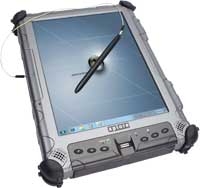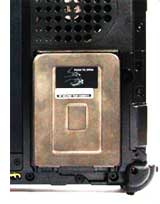« When the fire chief wants iPads instead of rugged gear | Main | Itronix RIP »
March 27, 2013
Xplore adds Common Access Card reader-equipped rugged tablet for military and government
This morning, March 27, 2013, Xplore Technologies introduced a new version of their ultra-rugged tablet computer, the iX104C5-M2. In essence, this is a specialized model for military and government personnel that require additional hardware security on top of the various security hardware, software and firmware measures already inherent in modern computing technology.  What the new M2 model adds is an integrated common access card (CAC) reader. With the reader, in order to get access to critical data, a U.S. government issued ISO 7816 smart card must be inserted.
What the new M2 model adds is an integrated common access card (CAC) reader. With the reader, in order to get access to critical data, a U.S. government issued ISO 7816 smart card must be inserted.
Why is the ability to read such cards and to provide data access only with such a card important? Because it's mandated in directives and policies such as the Homeland Security Presidential Directive 12 (HSPD-12) that requires that all federal executive departments and agencies use secure and reliable forms of identification for employees and contractors. A chip in the CAC contains personal data, such as fingerprint images, special IDs and digital certificates that allow access to certain federally controlled systems and locations. As a result, both Federal agencies and private enterprise are now implementing FIPS 201-compliant ID programs.
But what exactly do all those card terms mean? What's, for example, the difference between a CAC and a PIV card, and how do they relate to Smart Cards in the first place? Well, the term "smart card" is generic. It's simply a card with a chip in it. The chip can then be used for data storage, access, or even application processing. A CAC is a specific type of smart card used by the US Department of Defense. A PIV (Personal Identification Verification) card is also a FIPS 201-compliant smart card used by the Federal government, but it's for civilian users. Then there's also a PIV-I smart card where the "I" stands for "Interoperable," and that one is for non-Federal users to access government systems.
 The way a CAC works, specifically, is that once it's been inserted into the CAC reader, a PIN must be entered and the reader then checks via network connection with a government certificate authority server, and then either grants or denies access. The CAC stays in the reader for the entire session. Once it's removed, the session (and access) ends.
The way a CAC works, specifically, is that once it's been inserted into the CAC reader, a PIN must be entered and the reader then checks via network connection with a government certificate authority server, and then either grants or denies access. The CAC stays in the reader for the entire session. Once it's removed, the session (and access) ends.
What this means is that only computers that have a CAC reader can be used for certain military and other governmental work. And the new Xplore iX104C5-M2 provides that reader. It's built directly into the chassis where it is secured and protected.
I had a chance to talk with Xplore Technologies representatives prior to the release of the new model. They said they created this new version specifically to meet the requirements of the Department of Defense, the Air Force, and Homeland Security. According to them, the potential market for CAC-equipped ruggedized tablet is 50,000-100,000 units. Considering that a rugged Xplore tablet lists for over US$5k, that would value that market at between half a billion and a billion dollars. Xplore's competition, of course, will step up to bat as well, and not all CAC-equipped computers will require the superior ruggedness and portability of an Xplore tablet,. But it's easy to see why Xplore, a company with roughly US$30 million in annual sales, would throw its hat in the ring. Even winning a small percentage of the estimated value of this market could have a sizable impact on Xplore.
While I'm at it, let me recap what Xplore Technologies is all about and what they have to offer. Unlike the flood of Johnny-come-latelies attempting to grab a slice of the booming tablet market, Xplore has been making tablets for the better part of two decades. Starting in the mid-1990s, the company began offering some of the finest and most innovative rugged tablet computers available. They were at the forefront with integrating multiple wireless options into a rugged tablet, offering truly outdoor-readable displays, and providing dual mode digitizers that automatically switched between active pen and touch. We reviewed their current iX104C5 tablet platform in detail a couple of years ago (see here) and declared it "one of the best rugged tablet designs available today." In the meantime, Xplore has broadened the appeal of the platform with a number of versions targeted at specific industries and clienteles, and this latest M2 version continues that tradition with a very timely product.
See the Xplore iX104C5-M2 product page.
Posted by conradb212 at March 27, 2013 6:58 PM















